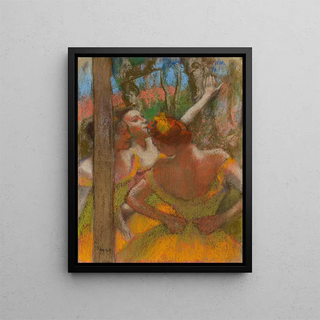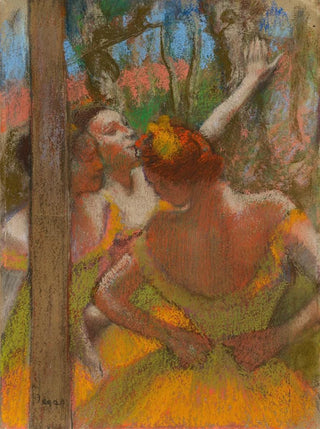Art print | Dancers - Edgar Degas


View from behind

Frame (optional)
Reproduction Danseurs - Edgar Degas – Introduction captivante
The "Danseurs" art print by Edgar Degas is a true invitation to delve into the fascinating world of classical ballet. This iconic impressionist piece captures a fleeting moment where grace and energy of the dancers blend in a striking visual harmony. Through this work, Degas does not merely depict figures in motion; he explores the beauty of the instant, the lightness of bodies, and the emotion emanating from the scene. The light, colors, and composition demonstrate an artistic mastery that transcends the simple act of painting. The art print thus invites viewers to feel the passion and discipline that inhabit each dancer, while offering an intimate view of this ephemeral art.
Style and uniqueness of the art print
Edgar Degas's style in "Danseurs" is characterized by a unique approach to movement and perspective. Unlike many artists of his time, Degas chooses to depict his subjects in natural poses, capturing moments of everyday life with an almost photographic precision. The color palette, subtle and nuanced, evokes the dim lighting of ballet scenes, while the brushstrokes, both delicate and dynamic, breathe palpable life into the characters. Degas also employs innovative viewing angles, often placing the viewer within the scene itself, creating a striking immersion. Every detail, from the fluid motion of tutus to the focused expression of the dancers, contributes to the authenticity of the art print, making "Danseurs" a masterpiece of impressionist art.
The artist and his influence
Edgar Degas, born in 1834, is one of the prominent figures of the impressionist movement, although he always claimed a more academic approach. His fascination with dance, which he observed closely in the ballet halls of the Paris Opera, deeply influenced his work. Degas does not limit himself to reproducing ballet scenes; he explores their psychology, preparation, and even the fatigue of dancers. His work has inspired many artists, both through his stylistic innovation and his capacity to capture

Matte finish

View from behind

Frame (optional)
Reproduction Danseurs - Edgar Degas – Introduction captivante
The "Danseurs" art print by Edgar Degas is a true invitation to delve into the fascinating world of classical ballet. This iconic impressionist piece captures a fleeting moment where grace and energy of the dancers blend in a striking visual harmony. Through this work, Degas does not merely depict figures in motion; he explores the beauty of the instant, the lightness of bodies, and the emotion emanating from the scene. The light, colors, and composition demonstrate an artistic mastery that transcends the simple act of painting. The art print thus invites viewers to feel the passion and discipline that inhabit each dancer, while offering an intimate view of this ephemeral art.
Style and uniqueness of the art print
Edgar Degas's style in "Danseurs" is characterized by a unique approach to movement and perspective. Unlike many artists of his time, Degas chooses to depict his subjects in natural poses, capturing moments of everyday life with an almost photographic precision. The color palette, subtle and nuanced, evokes the dim lighting of ballet scenes, while the brushstrokes, both delicate and dynamic, breathe palpable life into the characters. Degas also employs innovative viewing angles, often placing the viewer within the scene itself, creating a striking immersion. Every detail, from the fluid motion of tutus to the focused expression of the dancers, contributes to the authenticity of the art print, making "Danseurs" a masterpiece of impressionist art.
The artist and his influence
Edgar Degas, born in 1834, is one of the prominent figures of the impressionist movement, although he always claimed a more academic approach. His fascination with dance, which he observed closely in the ballet halls of the Paris Opera, deeply influenced his work. Degas does not limit himself to reproducing ballet scenes; he explores their psychology, preparation, and even the fatigue of dancers. His work has inspired many artists, both through his stylistic innovation and his capacity to capture






